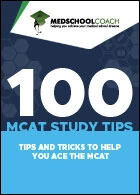
Table of Contents
The MCAT covers a wide variety of subjects, including biochemistry, physics, sociology, and organic chemistry. You’re required to take most of these MCAT subjects as undergraduate courses, but not math.
Many students overlook just how much math is on the MCAT — about 10%-20% of the exam will require some mathematical calculation. Some pre-meds get worried because they had a difficult time in previous math classes.
Don’t be overwhelmed. We’re here to help. In this comprehensive guide, we’ll cover everything you need to know about MCAT math, from rounding to manipulating equations. Then you’ll be better prepared for the MCAT, increasing your chances at medical school.
Looking to boost your MCAT score by 10 points or more? Get help from the nation’s best MCAT tutors.
You Only Get Scratch Paper on Test Day
You’ll need to find the correct answer to each math-related question by using only scratch paper. You will not be able to use a calculator for the MCAT.
Many students feel terror wash over them when they realize there’s no calculator allowed for the MCAT. But the absence of a calculator is good news in disguise — it means the level of calculations has to be relatively simple.
The AAMC calls their special scratch paper the ‘MCAT Test Day Noteboard Booklet.’ It’s a laminated booklet that comes with a wet-erase pen and plenty of space to write out your calculations.
In order to use the Noteboard Booklet efficiently, there are two things you need to be able to do:
- During your MCAT prep, you may need to relearn math concepts you haven’t seen since high school. This includes basic trigonometry, logarithms, exponents, scientific notation, and fundamental algebra.
You need to do lots of realistic practice questions and problems that require manual calculations on scratch paper during your study time. These realistic practice questions prevent you from over-relying on mental math during test day.
We recruited test prep experts to build the most accurate MCAT practice exam on the market.
What Kinds of Math Are Required for the MCAT?
The key math topics and calculations found on the MCAT include:
- Basic arithmetic (addition, subtraction, multiplication, division, fractions, proportions, square root estimations, ratios, and percentages)
- Algebra
- Trigonometry
- Interpreting graphs
- Statistics and probability
- Logarithms
- Scientific notation
- Coordinate geometry
- Exponents
There is no calculus or other advanced math on the MCAT.
MCAT math topics are designed to test reasoning abilities that are important for your success in medical school and as a physician. Top scorers develop a good number sense, which is the ability to think flexibly and critically about numbers and estimation.
Let’s take a look at how to approach some of the most important math rules and equations you’ll need for the MCAT.
1. Rounding
Rounding is your best friend. It shows up in virtually every type of MCAT math question.
The exam is not testing how precisely you can calculate values using complex numbers. Instead, rounding to friendly numbers (often whole numbers) is the way to go and is expected by the test makers. You can see this clearly in AAMC answer choices, as they are often approximations.
How much can you round on the MCAT? When rounding a number, it will always be safe to round up or down by 10% of the number you’re rounding.
For example: A passage describes Metformin, a medication to treat Type II diabetes, that has a molar mass of 165.62 g mol-1. You’re asked to find how many moles of the medication a patient will ingest if they take 625 milligrams twice daily.
Using our rounding rule, we know that 165.62 can be rounded up or down by 16.562. A good number sense tells us that rounding down to 150 is an easy number to work with. 625 can be rounded up or down by 62.5, so we choose to round down to 600.
This means you’re now working with the numbers 150 and 600 — which is much easier than 165.62 and 625.
Read Next: The 4 MCAT Sections – A Detailed Breakdown
2. Scientific Notation
When dealing with numbers that have many digits or working with numbers that are either very large or very small, scientific notation will save you a lot of headaches. It helps simplify calculations, comparisons, and representation of numerical data.
For instance, if you’re asked to multiply 0.000008 by 15,000, start by changing these numbers to something easier to work with. Try (8.0 x 10-6) x (1.500 x 104).
Now, we can multiply the whole numbers and the exponents separately:
- 8 x 1.5 = 12
- Adding our exponential terms together, we get 10-2
- The answer is quickly solved to be 12 x 10-2, or 1.2 x 10-1
Sometimes, you will need to manipulate the order of magnitude of a number that is in scientific notation. The rule is that when you move a decimal place to the right (making the coefficient larger), the exponent becomes smaller: 4.562 x 104 is the same number as 4562 x 101.
On the flip side, moving the decimal to the left and making the coefficient smaller makes the exponent larger: 782 x 101 is the same number as 7.82 x 103.
For when you take your practice test: MCAT Score Conversion Calculator
3. Multiplication
Multiplication on the MCAT is typically simple, though checking your answer on paper is usually a good idea to ensure you didn’t make a silly mistake! There’s no shame if your times tables through 12 are rusty. Set aside a little time to work through them until they’re automatic.
You may need to multiply two-digit numbers without rounding, which can be a bit tricky if you’re out of practice.
Here is an MCAT multiplication trick that helps make it more manageable:
Multiplying 32 x 17 might seem calculator-level, but it’s not! Mental math experts suggest turning this type of problem into a two-step math problem: 32 x 10 + 32 x 7. After all, multiplication is just fancy addition.
32 x 10 + 32 x 7 = 320 + 32 x 7
If you get stuck at 32 x 7, our strategy keeps working by turning this problem into:
32 x 10 + 30 x 7 + 2 x 7 = 320 + 210 + 14
The answer to this longer (but simpler) equation is 544.
With a bit of practice, you’ll be able to multiply any two-digit number with ease.
Read Next: High-Yield MCAT Topics
4. Division
Division is just as common as multiplication on test day. Thankfully, long division will not show up on your MCAT, as that would take too much time.
To simplify division problems, you can use rounding. Say you’re asked to divide 2209 N by 743 m/s2.
- You can round that to 2100 N / 700 m/s2.
- This is equivalent to the fraction 21 N / 7 m/s2, which is obviously equivalent to 3 N / 1 m/s2 or 3 kg.
- Based on this, you know the answer will be close to 3 kg.
Another MCAT division strategy involves thinking through how many times the denominator “goes into” the numerator. For instance, if you’re asked to solve 141 / 30, here’s how to go about it:
- Ask ‘how many times does 30 go into 141?”
- We can see that it goes in once (30), twice (60), three times (90), and four times (120) but not five times.
- From here, we try ½ of 30, and we see that 120 + 15 = 135. We should probably stop here and say the answer is roughly 4.5, but we could keep going and determine whether ¼ of 30 would get us closer to 141.
Learn More: Consider This Before Signing Up for Your MCAT Test Date
5. Dividing Exponents
Division of numbers in exponent form just involves fairly simple subtraction. From our previous discussion on rounding, let’s try to divide 600 mg / 150 g mol-1.
- First, we’ll need to fix our units using orders of magnitude: 600 mg is the same as 6 x 102 mg, but we need it in grams. The conversion factor here is 1 x 10-3, giving us 6 x 10-1 g.
- We end up with (6 x 10-1) / (1.5 x 102). Note the manipulation of 150 so that it is smaller than the numerator coefficient.
- Now, we figure out how many times 1.5 goes into 6. We can see that it goes in 4 times evenly, but what do we do with the exponents? When dividing exponents, subtract them. When multiplying exponents, add them together.
- This gives us our final answer of 4 x 10-3 moles.
6. Trigonometry
The MCAT wants you to be able to show a comprehensive grasp of the fundamental trigonometric principles, including:
- Defining basic trigonometric functions such as sine, cosine, and tangent, as well as their inverses (sin⁻¹, cos⁻¹, tan⁻¹).
- Identifying the sine and cosine values at key angles: 0°, 90°, and 180°.
- Understanding the relationships between the lengths of the sides of right triangles that involve angles of 30°, 45°, and 60°.
We can only use these trigonometric functions with right triangles. The functions are the ratios of the triangle side lengths:
- sin(θ) = opposite/hypotenuse
- cos(θ) = adjacent/hypotenuse
- tan(θ) = opposite/adjacent
A common mnemonic to remember these functions is SOH CAH TOA.
The inverse functions are:
- sin-1(θ) = hypotenuse/opposite
- cos-1(θ) = hypotenuse/adjacent
- tan-1(θ) = adjacent/hypotenuse
7. Logarithms
A logarithm is a mathematical function that represents the exponent to which a specified base must be raised to produce a given number. The logarithm base 10, often denoted as “log base 10” or simply “log,” calculates the exponent to which the base 10 must be raised to yield a specific number.
Logarithms on the MCAT are always log base 10 or, on occasion, the natural log (ln). The general form of the equation is log10(x) = y, where x is the number for which the logarithm is being calculated, and y is the exponent to which 10 must be raised to produce x.
Mastery of logarithms is essential for answering questions about acid-base chemistry as well as other physics and chemistry topics. They are particularly useful for simplifying calculations involving very large or very small numbers.
Certain log (and natural log) properties are useful to memorize:
- When taking the log of a number that is > 1, the answer will be positive.
- When taking the log of 1, the answer is 0.
- When taking the log of a number < 1, the answer will be negative.
- You can’t take the log of a number < 0.
MCAT Prep by MedSchoolCoach is a mobile-first MCAT study tool with videos, flashcards, question banks, and everything else you need to prepare for test day.
The Best Problem-Solving Strategies for MCAT Math
Questions that require numerical problem solving typically come in the Chemical and Physical Foundations of Biological Systems Section (Chem/Phys for short). Being able to quickly identify the correct equation(s), numbers, and mathematical setup is crucial.
Here are the best tips and strategies to set you up for MCAT math success:
- Practice makes perfect. The most important strategy is the most obvious: practice! You should complete practice problems multiple days a week during your MCAT prep. Review your practice test results and use of scratch paper to improve the speed of your calculations. Follow a foolproof study plan with ample time to hone your math skills and boost your percentile score.
- Use mental mental shortcuts. Mental math tricks can help you develop good, consistent number sense. Dedicate time to practicing mental math during your study week. Start with simple arithmetic operations such as addition, subtraction, multiplication, and division, and gradually increase the complexity of the problems as you become more comfortable.
- Addition/subtraction shortcut. When adding 7, 8, or 9 to a number, try to think of it as adding 10, and then subtracting the difference. For example, instead of 74 + 8, try 74 + 10 – 2. This also works for subtraction — instead of subtracting 7, 8, or 9 from a number, subtract 10 and add the difference. 346 – 127 should be taken in two steps: 346 – 120 = 226, and then 226 – 10 + 3 = 219.
- Logarithm shortcut. You may be asked to find the log base ten of a number that isn’t a multiple of 10. Consider log(7). One simple trick is to realize that the log of any number between 1 and 10 is going to work out to somewhere between 0 and 1. For simplicity’s sake, let’s estimate log(7) to be 0.5. This can help us evaluate the log of longer expressions. Now consider log(7 x 105). If we estimated log(7) to be 0.5, then we know log(7 x 105) will be roughly equal to 0.5 + log(105). And since the log of any exponent of 10 is simply the exponent itself, we can estimate the answer to be 0.5 + 5 or 5.5.
- Memorize your MCAT physics and chemistry equations. Make a point to write them out from memory. An equation will often have to be manipulated algebraically to solve for a particular variable. The best equation strategy is to complete all of the algebraic manipulations of an equation before trying to plug in numbers. This will allow you to cancel out terms that may appear on both sides of the equation. (Download our complete guide to every Chem/Phys equation you need to know for the MCAT.)
Let’s look at an example of this last point: If asked for the final velocity of an object during free fall, we can use kinetic and potential energy equations, 1/2mv2 and mgh respectively.
A quick setup of the two equations gives us mgh = 1/2mv2.
We know we’re solving for v, but before we start to rearrange the relationship, notice the mass terms cancel out, leaving us with gh = 1/2v2.
Next, we move the ½ and exponential terms to give v = √2gh. Only now should you plug in the relevant numbers and do the math.
Read Next: How Many Times Can You Take the MCAT? Yearly/Lifetime Limits
FAQs
No, there is no calculator provided on the MCAT. You are given a laminated scratch paper booklet. Special testing accommodations from the AAMC may allow a calculator.
The math on the MCAT is simple, but that doesn’t mean it’s easy. Although MCAT math is high school level, the short time you have to solve problems can make even simple math difficult.
If you follow our tips above, you should easily answer MCAT questions with math, even without a calculator.
Best strategies include practicing (a lot), rounding by up to 10% of the original numbers to make them easier to work with, using scientific notation, and memorizing formulas, basic trigonometry, and logarithmic equations.
There are a lot of formulas and equations you need to know for the MCAT. Download a complete list here.
Be sure to spend time with each one that you encounter during your test prep. Know the equation, units, and the scenarios in which they are used.
Get MCAT Tutoring from 99th Percentile Tutors
MCAT prep doesn’t have to feel daunting. Our tutors can teach you additional shortcuts and tips for mastering MCAT math, plus how to stay calm and not stress out on test day.
Let our 99th-percentile tutors help you increase your MCAT score by 12 points or more!

Ken Tao, PhD
Ken is the Director of MCAT and Research at MedSchoolCoach. He is an alumnus of UC Berkeley and Harvard University, boasts degrees in Bioengineering, Molecular and Cell Biology, and a Ph.D. in Neuroscience. Ken previously worked with undergraduate students at Princeton Review where he was the only tutor certified in all subjects. Ken was one of the highest rated MCAT tutors ever and a teacher trainer. He founded Magoosh's MCAT division and has written content for dozen's of MCAT books and guides.





